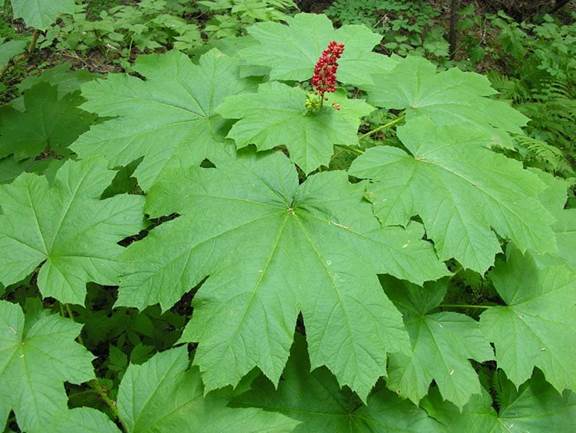Some intervales of fair weather last night, rain continue this morning. I walked up the Brook & assended the first Spur of the mountain with much fatigue, the distance about 3 miles, through an intolerable thickets of Small pine, a groth much resembling arrow wood on the Stem of which there is thorns; this groth about 12 or 15 feet high inter lockd into each other and Scattered over the high fern & fallen timber, added to this the hills were So Steep that I was compelled to draw my Self up by the assistance of those bushes— William Clark, Nov 13 1805, Near Dismal Nitch along the Columbia River. Clark describing what appears to be Devil’s Club.
If you have spent any time in the Pacific Northwest bushwacking off-trail, tripped over a branch, and absently-minded grabbed for the nearest stem for balance, you may have been unlucky and run into this shrub. It is just downright nasty – even its scientific name screams “heads up!” Oplopanax –Latin oplo – weaponry, and panax – a cure, such as in panecea. Also a reference to the genus Panax and the medicinal value of ginseng. So the genus means the oxymoronic – heavily armored cure. The species name, horridum – leaves little to the imagination. The plant has large leaves with woody stems covered in spines. And insult to injury – the spines have a mild irritating, toxin.

Devils club, also known as devil’s walking stick, can be found in forests from coastal Alaska southward and eastward to California, the northern Rockies, and a disjunct population near northern Lake Superior and central Canada. This plant grows to between 3 and 5 ft. tall but in some temperate rainforest ravines it may stretch up to 16 ft. tall. Now there’s a nightmare. The leaves are spirally arranged around the stems and up to 16 inches across. The plant is covered in small, brittle, yellow spines that break of easily if disturbed and looks overall rather primitive and threatening. It is found in moist forests in a variety of conditions from well drained slopes to wetland seeps. Bears will eat large quantities of the abundant berries in mid-summer and help spread the seed through their droppings. Devils club often will be an early colonizer of disturbed sites in the forest at the scene of landslides, blow-downs, and logging.
This plant was (and is) incredibly important in Native American and First Nation cultures such as the Tlingit, Haida, Salish, Tsimshian, Hesquiat, and Nuxalt through the plant’s range. Its use is quite varied and includes fishhooks and lures, tattoo ink from its charcoal, traditional medicines to cure arthritis and tuberculosis, as a deodorant, to treating lice. Shaman’s use includes purification and cleansing and combating witchcraft. A piece of devil’s club hung over the doorway is said to ward off evil in the Tlingit and Haida cultures. It also is known as Alaska ginseng and harvest for medicinal use.If you are interested you can make your own salve: http://www.alaskafloatsmyboat.com/beachcombing/2013/5/15/making-devils-club-salve-and-tincture
I’ve had the distinct pleasure of running into, or from, this plant on numerous occasions while recreating or working in the field. On one trip some friends and I were bushing it up some steep slope with full climbing packs on some god-forsaken Cascade approach to the Picket Range. It was drizzling, we were hot under the raingear, sweaty, and annoyed with the bugs – the usual Cascade experience, when Steve slipped, toppled over, and started sliding on his back, headfirst down the slope. We watched helplessly while he desperately grabbed some devil’s club going by and it raked his palm as it slid through his grasp.
He finally slowed himself down, cursing the hundreds of spines in his hand and while trying to right himself like and upended turtle. That’s when the yellow-jackets came out of their ground nest to investigate the racket. It wasn’t pretty. We decided that the trip just wasn’t meant to be this time and retreated out and soothed ourselves with buffalo burgers and beer in Marblemount while Steve painstakingly picked out spines from his hands and forearms with tweezers. So appreciate this plant while you’re hiking on a trail because you likely will not do so if you are crashing through the forest and like many, grab its stem for balance. It really is an iconic northwest plant.
